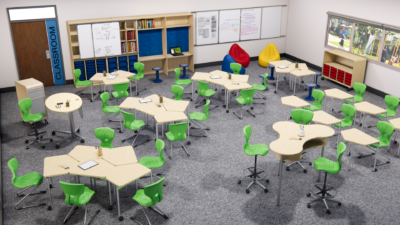Designing 21st Century Dynamic Classrooms
For over 25 years, JMC has been at the forefront of designing educational spaces and providing school furniture, boasting a team of skilled designers well-versed in 21st-century classroom needs. With a wealth of experience from designing numerous spaces, JMC has access to top-notch school furnishings, enabling the creation of active learning classrooms in any space.
Why are Active Learning Classrooms Important?

In today’s educational landscape, the focus has shifted towards active learning where students take center stage. Extensive research supports dynamic classrooms, showing that diverse teaching methods better support student learning. Traditionally, classrooms were teacher-centric, relying on lectures as the primary mode of instruction. However, this approach does not foster a culture of learning among students and may not accommodate diverse learning styles.
As teaching methodologies evolve, classrooms are also transforming. Educators are embracing various teaching methods to engage all learners effectively. Studies indicate that students thrive in active learning environments, where they can collaborate, work independently, and utilize digital resources. Modern classrooms are flexible, allowing for one-on-one interactions, group work, and digital connectivity. Studies have shown that students, not only enjoy being in an active learning classroom, but that their educational results are positively impacted. Modern classroom design allows teachers and students to work one on one, students to work in smaller or larger groups as necessary. The 21st century classroom has all requirements for students to connect digitally. This is especially important as technology use in schools has increased and shows no sign of slowing down. The flexibility of a classroom to be able to accommodate independent study as well as collaboration is a must to effectively teacher modern students

The physical layout of classrooms must align with modern teaching strategies. Angel Ford emphasizes the importance of providing teachers with proper facilities and training to utilize classroom spaces effectively. Simply rearranging desks or constructing new buildings may not suffice without adequate teacher training. Teachers play a crucial role in making active or dynamic classrooms effective, and proper training is essential to address challenges like student distraction and teacher discomfort.
“Without the proper facilities, teachers are limited in the pedagogical techniques they can utilize. As teachers are being required to differentiate teaching strategies, they need to be provided with the appropriate resources, including the most effective physical environments and classroom layouts and the training to use those spaces effectively.” It is not enough to have a good classroom design teachers need training on how to use the space effectively. Simply moving desks around may not be the best answer; and neither will the construction of new state-of the-art buildings and/or classrooms if teachers are not trained how to utilize these spaces. Not only do the learning spaces need to be adapted, teachers also need training on how to best arrange their classrooms and utilize these arrangements effectively (Mercier, Higgins, & Joyce-Gibbons, 2014)
Jonathan Morgan and Company specializes in designing educational spaces tailored to meet the demands of dynamic classrooms. With a deep understanding of active learning principles, JMC ensures that educators can seamlessly transition between teaching styles while catering to the diverse needs of learners. Through innovative designs and comprehensive training, JMC empowers educators to create engaging and effective learning environments.


